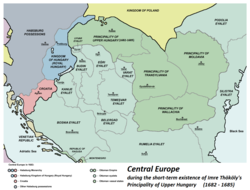
Back المجر العثمانية Arabic Osmanlı Macarıstanı Azerbaijani Унгарските земи под османско владичество Bulgarian Osmanské Uhersko Czech Hungría otomana Spanish Osmanite vallutatud Ungari Estonian Hongrie ottomane French הונגריה העות'מאנית HE Török hódoltság Hungarian Hungaria Utsmaniyah ID
Ottoman Hungary Török hódoltság (Hungarian) | |
|---|---|
| 1541–1699 | |
 Ottoman rule on Hungary at its peak in 1683, including Budin, Egri, Kanije, Temesvar, Uyvar, and Varat eyalets. The semi-independent Principality of Transylvania was an Ottoman vassal state for the majority of the 16th and 17th centuries, the short lived Imre Thököly's Principality of Upper Hungary also briefly became an Ottoman vassal state due to an anti-Habsburg Protestant uprising between 1682 and 1685. | |
| Common languages | Hungarian |
| Religion | Roman Catholicism Reformed Church in Hungary Islam |
| Demonym(s) | Hungarian |
| Government | |
| Beylerbey, Pasha, Agha, Dey | |
| History | |
| 1541 | |
| 1686 | |
| 1699 | |
| Today part of | Hungary, Croatia, Serbia, Slovakia, Romania |
| History of Hungary |
|---|
 |
|
|
Ottoman Hungary (Hungarian: Török hódoltság, literally "the Turkish subjugation") encompassed those parts of the Kingdom of Hungary which were under the rule of the Ottoman Empire from the occupation of Buda in 1541 for more than 150 years, until the liberation[1] of the area under Habsburg leadership (1686–1699). The territory was incorporated into the empire, under the name Macaristan.[2] For most of its duration, Ottoman Hungary covered Southern Transdanubia and almost the entire region of the Great Hungarian Plain.
During the period of Ottoman rule, Hungary was divided for administrative purposes into Eyalets (provinces), which were further divided into Sanjaks. Ownership of much of the land was distributed to Ottoman soldiers and officials with about 20% of the territory being retained by the Ottoman state. As a border territory, much of Ottoman Hungary was heavily fortified with troop garrisons. Remaining economically under-developed, it became a drain on Ottoman resources. During the centuries long three-way Hungarian–Habsburg–Ottoman wars the Hungarian population highly decimated.[3] Although there was some immigration from other parts of the Empire and some conversions to Islam, the territory remained largely Christian. The Ottomans were relatively religiously tolerant and this tolerance allowed Protestantism to gain traction, unlike in Royal Hungary where the Habsburgs repressed it. By the end of the 16th century, around 90% of the population was Protestant, mainly Calvinist.
In 1686, Buda was recaptured from the Ottomans, and in 1687, after the Second Battle of Mohács, the Hungarian parliament recognized that the inheritance of the Hungarian crown had passed to the Habsburgs. The imperial armies pushed the Turks out of Hungary relatively quickly and occupied Transylvania as well. Following the defeat of the Ottomans in the Great Turkish War, the Ottomans recognized the loss of the Ottoman Hungary by the Treaty of Karlowitz in 1699. The remaining Ottoman occupied territories (that encompassed the southern border regions of the Kingdom of Hungary), Temeşvar Eyalet, Syrmia and Belgrade, were reconquered by the Habsburgs during the Austro-Turkish War between 1716 and 1718, the cession of these regions was acknowledged by signing of the Treaty of Passarowitz in 1718.[4]
- ^ "A Guide to the United States' History of Recognition, Diplomatic, and Consular Relations, by Country, since 1776: Hungary". Office of the Historian.
- ^ Bilge, Sadik Müfit (2010). Osmanlı'Nın Macaristanı - Osmanlı Hakimiyetindeki Macaristan'In Tarihi Coğrafyası Ve İdari Taksimat-Sadık Müfit Bilge Değerlendirmeleri (in Turkish). Istanbul: Kitabevi Yayınları.
- ^ Cite error: The named reference
Palffy Ottoman Hungary 2001was invoked but never defined (see the help page). - ^ Ingrao, Charles; Samardžić, Nikola; Pešalj, Jovan, eds. (2011). The Peace of Passarowitz, 1718. Purdue University Press. doi:10.2307/j.ctt6wq7kw.12. ISBN 978-1-61249-179-0. JSTOR j.ctt6wq7kw.